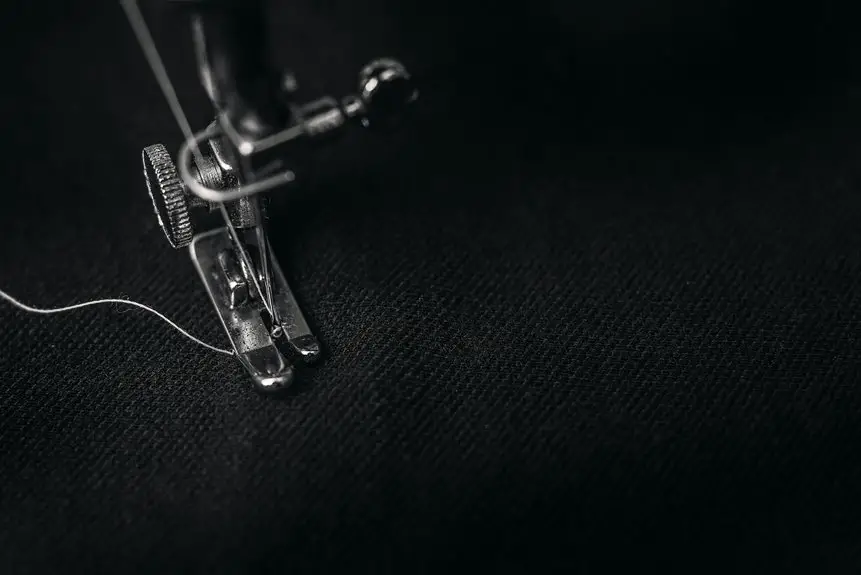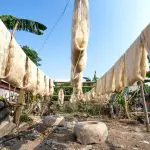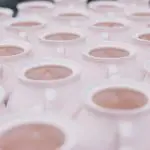When seaming Kevlar laminate fabric, use a heavy-duty sewing machine with a Kevlar or polyester thread, sewing slowly with medium stitch length to avoid damaging fibers. For bonding, clean and lightly abrade surfaces, then apply a flexible, durable adhesive like epoxy. Always wear cut-resistant gloves, eye protection, and guarantee good ventilation to stay safe. With proper tools and techniques, you’ll preserve Kevlar’s strength and durability—keep exploring to master its unique challenges and care tips.
Table of Contents
Key Takeaways
- Use a heavy-duty sewing machine with Kevlar or polyester thread and a leather or denim needle to seam Kevlar laminate fabric effectively.
- Align fabric edges evenly, pin securely with heat-resistant pins, and sew at medium stitch length without backstitching for strong seams.
- Clean and lightly abrade bonding surfaces, then apply epoxy or polyurethane adhesive, following curing instructions for durable Kevlar laminate bonds.
- Wear cut-resistant gloves, eye protection, and a dust mask while working to avoid injury from sharp fibers and airborne particles.
- Maintain low sewing speeds and proper tension to prevent fabric damage, and press seams gently with a low-heat iron for uniformity.
Understanding the Properties of Kevlar Laminate Fabric
Kevlar laminate fabric combines exceptional strength and flexibility, making it ideal for protective applications. When you work with this material, you’ll notice its high tensile strength resists tearing and punctures, while the laminate adds durability against abrasion and moisture.
It’s lightweight, so you won’t feel weighed down, yet it offers incredible impact resistance. The fabric’s heat resistance means it won’t easily degrade under high temperatures, which is vital for safety gear. You’ll also appreciate its chemical resistance, which helps maintain integrity in harsh environments.
Keep in mind that its unique texture can affect handling, and cutting requires sharp tools to prevent fraying. Understanding these properties guarantees you can handle Kevlar laminate fabric confidently and make the most of its protective qualities.
Essential Tools and Materials for Seaming Kevlar
Working with a tough laminate fabric like this means you’ll need the right tools and materials to create strong, reliable seams.
Start with a heavy-duty sewing machine equipped with a sharp, durable needle designed for thick fabrics, such as a leather or denim needle. Use high-strength, UV-resistant thread—Kevlar or polyester thread works best to guarantee durability.
You’ll also want heat-resistant scissors or rotary cutters for clean, precise cuts. To hold layers securely, use clips instead of pins to avoid damaging the fabric.
For bonding, select adhesives specifically formulated for aramid fibers or laminate materials. Finally, protective gloves and safety glasses will keep you safe during cutting and bonding.
Having these essentials ready sets you up for success when seaming Kevlar laminate fabric.
Step-by-Step Guide to Seam Kevlar Laminate Fabric
A successful seam starts with careful preparation and precise execution. First, align the Kevlar laminate edges evenly. Next, use a rotary cutter to trim any uneven parts. Pin the edges with heat-resistant pins to prevent shifting. Then, set your sewing machine to a medium stitch length and use a heavy-duty needle designed for Kevlar.
| Step | Action |
|---|---|
| 1 | Align and trim fabric edges |
| 2 | Pin edges securely |
| 3 | Select appropriate needle |
| 4 | Sew with medium stitch length |
Finally, sew slowly, keeping tension consistent. Avoid backstitching on Kevlar to prevent fiber damage. Once sewn, press the seam lightly with a low-heat iron and check for uniformity. This method guarantees a durable, clean seam.
Effective Bonding Techniques for Kevlar Laminate
You’ll want to start by properly preparing the Kevlar surface to guarantee strong adhesion.
Choosing the right adhesive based on flexibility and durability is essential for a lasting bond.
Finally, follow the correct curing process and safety measures to achieve the best results without risks.
Surface Preparation Methods
Since Kevlar laminate’s unique fibers resist many adhesives, preparing the surface properly is essential to guarantee a strong bond. You’ll want to clean the fabric thoroughly, removing oils or dust that block adhesion. Light abrasion with fine sandpaper or a scouring pad roughens the surface, helping adhesives grip better. Avoid aggressive sanding to prevent fiber damage. After sanding, wipe the area with isopropyl alcohol to eliminate residues. Proper preparation sets the stage for durable seams and secure bonds.
| Step | Emotion | Outcome |
|---|---|---|
| Clean surface | Confidence | Adhesive adheres well |
| Light abrasion | Control | Better mechanical grip |
| Alcohol wipe | Assurance | Residue-free surface |
| Careful handling | Respect | Intact Kevlar fibers |
Adhesive Selection Criteria
Though Kevlar’s fibers offer remarkable strength, choosing the right adhesive plays an essential role in guaranteeing a durable bond. You need an adhesive that can handle Kevlar’s low surface energy and flexible nature without compromising strength.
Look for epoxy or polyurethane adhesives known for excellent adhesion and flexibility. Ascertain the adhesive has good resistance to environmental factors like moisture and temperature changes, as Kevlar applications often face harsh conditions.
Also, consider the cure time—select an adhesive that fits your workflow without sacrificing bond quality. Avoid adhesives that may degrade Kevlar’s fibers or cause brittleness.
Finally, check compatibility with your surface preparation method to assure peak adhesion. Making the right choice here sets the foundation for a strong, long-lasting Kevlar laminate bond.
Curing and Safety Practices
When bonding Kevlar laminate, curing the adhesive properly is essential to achieve maximum strength and durability. You need to follow the manufacturer’s recommended temperature and time precisely, as under-curing can weaken the bond, while over-curing might damage the fabric.
Use a controlled environment like a temperature-regulated oven or press to guarantee consistent curing. Always wear appropriate personal protective equipment such as gloves and safety glasses to protect against chemical exposure.
Work in a well-ventilated area to avoid inhaling fumes. Keep your workspace clean and organized to prevent contamination of the adhesive or fabric.
Safety Precautions When Handling and Working With Kevlar
When working with Kevlar, you should always wear protective gear like gloves and masks to avoid irritation from fibers.
Make sure your workspace has good ventilation to control dust and airborne particles.
Taking these steps helps keep you safe during handling and fabrication.
Protective Gear Essentials
Handling Kevlar laminate fabric demands specific protective gear to guarantee your safety and maintain the material’s integrity.
You should wear cut-resistant gloves to protect your hands from sharp edges and fibers that might cause irritation or minor cuts. Long sleeves and pants made from tightly woven fabric help shield your skin from airborne fibers.
Eye protection, like safety goggles, is essential to prevent any stray fibers from entering your eyes during cutting or sewing. Additionally, use a dust mask or respirator to avoid inhaling any microscopic particles released during handling.
Make certain your protective gear fits well and is comfortable, so you won’t be tempted to remove it while working. Following these precautions guarantees you work safely without compromising Kevlar’s performance.
Ventilation and Dust Control
Along with wearing the right protective gear, you need to manage ventilation and dust control to keep your workspace safe while working with Kevlar laminate fabric. Cutting, sanding, or trimming Kevlar can release fine fibers and dust that irritate your skin, eyes, and lungs. Use local exhaust ventilation systems or work near open windows to reduce airborne particles. A HEPA-filter vacuum helps capture dust, preventing it from settling on surfaces or being inhaled.
| Ventilation Method | Purpose |
|---|---|
| Local Exhaust Ventilation | Removes airborne fibers at source |
| Open Windows | Provides fresh air circulation |
| HEPA Vacuum | Captures fine dust effectively |
| Air Purifiers | Filters remaining airborne particles |
| Regular Cleaning | Prevents dust accumulation |
Stay proactive with ventilation to protect your health during every step.
Common Challenges and How to Overcome Them
Although Kevlar laminate fabric offers exceptional strength and durability, you’ll face specific challenges during its use and maintenance. Understanding these obstacles helps you handle the fabric effectively and extend its lifespan.
Here are the common challenges and how you can overcome them:
- Difficulty in Seaming: Kevlar’s tough fibers resist conventional stitching. Use specialized needles and slower stitching speeds to avoid damaging the fabric.
- Adhesive Compatibility: Not all adhesives bond well with Kevlar laminates. Test adhesives on small samples first and choose those designed for high-performance fabrics.
- Cutting Precision: Kevlar layers can fray or shift during cutting. Use sharp rotary cutters and secure the fabric firmly to maintain clean edges.
Frequently Asked Questions
Can Kevlar Laminate Fabric Be Recycled or Reused?
You can recycle or reuse Kevlar laminate fabric, but it’s tricky due to its strong, layered nature. You’ll need specialized processes or creative repurposing ideas to make the most of its durability and strength safely.
What Industries Commonly Use Kevlar Laminate Fabric?
You’ll find Kevlar laminate fabric widely used in aerospace, automotive, military gear, and sporting goods industries. Its strength and lightweight nature make it perfect for protective clothing, helmets, and high-performance equipment you rely on daily.
How Does Temperature Affect the Durability of Kevlar Seams?
You’ll notice that exposing seams to extreme heat can gently challenge their strength, potentially softening bonds and reducing durability. So, you’ll want to keep temperatures moderate to maintain the integrity and long-lasting performance of your seams.
Are There Environmentally Friendly Adhesives for Bonding Kevlar?
Yes, you can use eco-friendly adhesives like water-based or bio-based epoxies for bonding Kevlar. They reduce harmful emissions, are less toxic, and still provide strong, durable bonds without compromising performance or safety.
Can Kevlar Laminate Fabric Be Dyed or Printed On?
You might think Kevlar laminate fabric can’t be dyed or printed on, but you can use specialized inks and dye processes designed for synthetic fibers. Just guarantee you test for durability, as regular methods won’t work well.
- Are Polyamide Bras a Good Choice? Pros, Cons, and Expert Opinions - June 30, 2025
- How to Eliminate Static Cling From Polyamide Fabrics for Good - June 30, 2025
- 5 Easy Ways to Get Wrinkles Out of Polyamide Clothing - June 30, 2025





